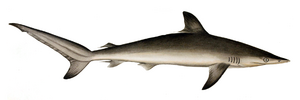Spot-tail shark facts for kids
Quick facts for kids Spot-tail shark |
|
|---|---|
 |
|
| Conservation status | |
| Scientific classification | |
| Genus: |
Carcharhinus
|
| Species: |
sorrah
|
 |
|
| Range of the spot-tail shark | |
| Synonyms | |
|
|
The spot-tail shark, also known as the sorrah shark (Carcharhinus sorrah), is a type of requiem shark. These sharks live in the warm, tropical waters of the Indo-West Pacific Ocean. You can find them from the surface down to about 72 meters (236 feet) deep. This shark can grow to be about 1.6 meters (5.2 feet) long. People often fish for them, and because of this, the IUCN (a group that tracks animal populations) says they are "near threatened". This means their numbers are getting low.
Contents
What Does It Look Like?
The spot-tail shark has a sleek, torpedo-shaped body. It has a fairly long, pointed snout and eyes that are a good size. Its first dorsal fin (the one on its back) is large and curved. The second dorsal fin is much smaller and lower.
The shark's back and sides are grey, and its belly is white. It also has a long white stripe along its side. You can tell this shark apart from other similar sharks by the black tips on its fins. Look for black tips on its second dorsal fin, its pectoral fins (the ones on its sides), and the lower part of its tail fin. It also has a small ridge along its back between its two dorsal fins.
Another shark, the Australian blacktip shark (C. tilstoni), looks similar. It also has black tips on its fins, but it has a black tip on its first dorsal fin too. The Australian blacktip shark does not have the ridge between its dorsal fins, and its teeth are different.
Where Does It Live?
The spot-tail shark lives in tropical parts of the Indo-Pacific region. It prefers the shallow waters over continental and island shelves. They are usually found at depths around 73 meters (240 feet), but sometimes they can go as deep as 140 meters (460 feet). Their home range stretches from the coast of East Africa, including Madagascar and the Red Sea, all the way to India, Malaysia, China, the Philippines, and northern Australia.
Life and Habits
Spot-tail sharks have an interesting daily routine. During the day, they tend to stay closer to the seabed. But at night, they swim up closer to the surface. They often hang out around coral reefs. These sharks are predators, meaning they hunt other animals for food. They eat bony fish like bonito and sea bass, as well as squid and crabs.
Reproduction and Life Cycle
Spot-tail sharks give birth to live young, just like mammals. They have a special connection called a yolk-sac placenta, which helps the babies grow inside the mother. They usually have babies once a year, with a litter of one to eight pups. The mother carries her babies for about 10 months. When they are born, the baby sharks are about 50 centimeters (20 inches) long.
Young sharks grow up in shallow waters near the coast. They grow very quickly at first, adding about 20 centimeters (8 inches) to their length in their first year. After that, their growth slows down. Female spot-tail sharks become ready to have babies when they are two to three years old. They can live for up to seven years, while males usually live up to five years.
Conservation Status
People catch spot-tail sharks in many places using lines and gillnets. These sharks are caught by small fishing businesses. Their meat is used for food, their liver for vitamins, and their fins for shark fin soup. Other parts are used to make fish meal for animals.
The IUCN has listed the spot-tail shark as "near threatened". This is because too many of them are being caught in many areas, and their populations seem to be shrinking. However, the fishing for these sharks in northern Australia is managed better, which helps protect them there.


